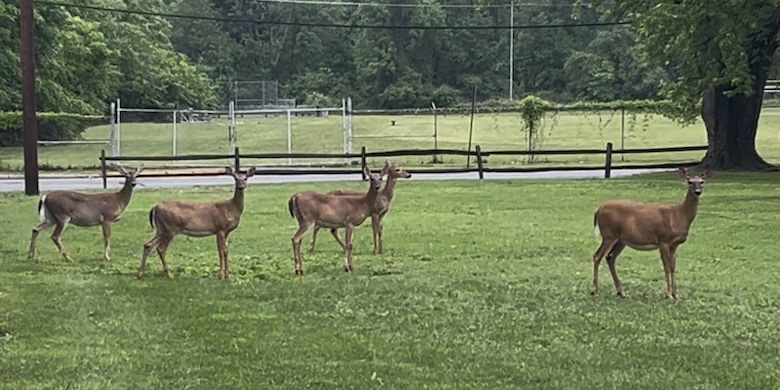Please be aware that deer are living around our community - off Clayton & Magnolia Roads - and may be seen more frequently in residential areas in town as construction down the street at the Hampton Road housing development appears to have driven them from that wooded habitat to find vegetation. New Jersey’s white-tailed deer herd is a major component of the landscape throughout all areas of the state. They can be found everywhere in New Jersey, standing in fields, grazing next to roads, and even strolling
through suburban front lawns and backyards in broad daylight. Most adults roam an area of less than one square mile. Deer eat the leaves, stems, and buds of woody plants throughout the year. Fruits and nuts (especially acorns), garden vegetables, flowers, and agricultural crops are important seasonally. Fawns are born in late May or June. For the first month, fawns lie still and hide much of the time, and may appear to have been abandoned. The mother forages relatively nearby and periodically returns throughout the day to nurse. Within a month, the fawns are strong and agile enough to travel and forage with their mothers.
“White-tailed” refers to the white underside of the tail, which is held conspicuously erect like a flag when the animal is alarmed or running. Overabundant deer populations can have negative impacts on humans, as well as on the local ecology. Deer can also introduce and support the spread of invasive plant species. Native species often are the preferred food choice for deer, which consequently provides an advantage to invasive species’ establishment.
Please do not approach or feed deer. NJDEP Fish & Wildlife Code states that feeding can cause deer to lose their fear of humans and enhance the spread of disease. People should keep in mind that that deer and other wildlife are wild animals and have adapted to cope to temperatures and high winds. Feeding is defined as placing food, either natural or artificially produced, with the intent of supplementing the naturally occurring food available to deer in their normal home range. Supplemental feeding does not include leaving unharvested agricultural crops, leaving agricultural bi-products in place after normally accepted harvesting, cutting native vegetation or artificially fertilizing herbaceous or woody sites, or baiting for the purposes of hunting.
NJDEP provides a Deer Disease Sighting Form to investigate potential disease outbreaks and to assist staff in sampling efforts.
